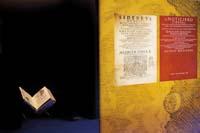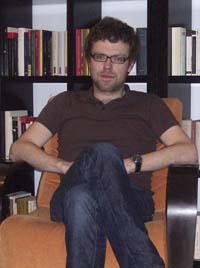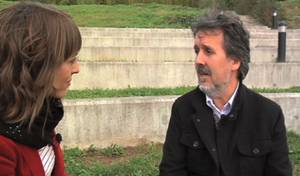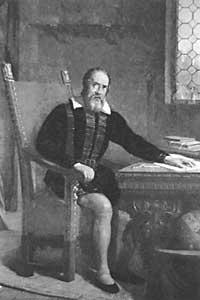Text written in Basque and translated automatically by
Elia without any subsequent editing.
SEE ORIGINAL
Information about the stars Sidereus nuncius
2010/04/01
Roa Zubia, Guillermo - Elhuyar Zientzia
Iturria:
Elhuyar aldizkaria
The moon is not perfect. The first to realize was Galileo Galilei. And through the book Sidereus nuncius tried to spread this news. That is why for many it was the first informative book in the history of science. A copy of the first edition of this Sidereus nuncius is now on display at the Planetarium of Pamplona, an exhibition in which other objects from Galileo can be seen. Along with this exhibition, several translations of the book have been presented, including the one translated into Basque through the Elhuyar Foundation.
Information about the stars Sidereus nuncius
01/04/2010 | Roa Zubia, Guillermo | Elhuyar Zientzia Komunikazioa

(Photo: Planetarium of Pamplona)
"To be a perfect dissemination book, it is only necessary that it is not in Latin," says Ramón Núñez, curator of the exhibition that shows a copy of the original edition of the Sidereus nuncius. "He wrote all the other books in the language of the people, in which he can be considered Italian of that time."
Whether perfect or not, it is a brave book. Galileo reveals the first surprises in telescope observation. He tells us of the mountains of the Moon, of many stars that are not seen at first sight and, finally, of four satellites of Jupiter. "It gives very important news," says Núñez. "This is the news of the universe. At the beginning of the 20th century we had an incorrect idea of Aristotle."
In fact, the book was a set of research notes. "Galileo spent six hours a day looking from the glasses and at the end noted what was seen. He began in November 1609 and finished his work for March 2. In the meantime, it took a 16-day break, that is, the sky was cloudy and I couldn't see anything," says Ibon Plazaola. He has translated into Basque on behalf of the Elhuyar Foundation, and knows the history of the time perfectly.
Galileo collected this work and published it in a stellar informative (a sidereus nuncius). However, the title of the book is not just those two words. Following the custom of the time, the title defines the author, its content and its memory. This last detail is very important. With the book prepared for publication, Galileo himself did not know in his honor: In homage to Duke Cosme II of the Medici family or to the whole family. "The book began to be printed leaving the title for later and asked for advice," says Núñez. "He finally decided to call the stars Meditate on the satellites of Jupiter, believing that the name was more appropriate, and printed the whole book." However, history has covered the name of Medici, which we call Galilean satellites.
Ibon Plazaola: "Galileo's Latin is nothing rhetorical"
On behalf of the Elhuyar Foundation, Ibon Plazaola has translated the book Sidereus nuncius into Basque, live from Latin. The translation was presented at the Congress of Scientific Communication in Pamplona.
We say it is a historical book. All books are historical.
Yes. We must not understand the historical word as a corset. It is historical because the book was important. In this book Galileo made known several observations made thanks to a new gadget or a new assumption.
Telescope...
We call it a telescope, but Galileo still did not know that what he had was a telescope, since the word telescope was invented shortly afterwards. That is very curious, when I was translating the text it has given me one of the biggest headaches: how to give in Basque the word it uses, because the word telescope (it is anachronism) could not be used.
Your choice has been a goggle.

Translator by Ibon Plazaola Bakun. Ed. : Ainhoa Iribar.
Yes. He also uses it in Latin: perspiculum. This is what the surrounding languages translate: lunette in French, anteojo in Spanish, spyglasses in English,... And in Basque I also needed it. The names of the satellites of Jupiter --Ganymede, Io, Europe and Callisto - are also later. Galileo told them the Midwayer star.
XVII. Is 20th century Latin equal to the present?
No, they are obviously not the same. The tongue is dead, they say so. Today, if I am not mistaken, the only ones able to speak well in Latin are those who condemned Galileo, the cardinals of the Vatican, etc. Therefore, currently, when you study Latin or classical Greek, you learn Latin or Greek in the texts. XVII. Latin of the twentieth century is called neolatine, where there were various morphosyntactic adaptations, etc. So it's another Latin within Latin; the Latin they used Galileo is not at all what I know. But I am able to understand and translate that Latin.
Is it a difficult text?
They are long and rhetorical phrases. However, the style of Galileo is very clear and diafano. His Latin is nothing rhetorical. He uses a very elegant Latin, but it is nothing “wired”.
How does the opportunity arise to translate this important book?
The truth is that most things happen, even the happiest. I started this translation because we were commissioned. I worked at the translation company Bakun and at the translation company the Elhuyar Foundation asked him if there was any "madman" capable of translating from Latin to Basque, and in the company Bakun there was a madman: myself. And he knew the work of Galileo and the age. I greatly appreciate the time and Latin of the time. So things happened. And I have done it very well.
Roa Bridge, Guillermo
Services
263
2010
Security
014
History; Astronomy; Bibliography
Article
Security









